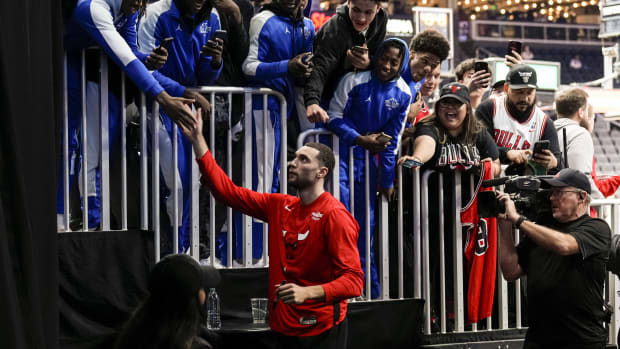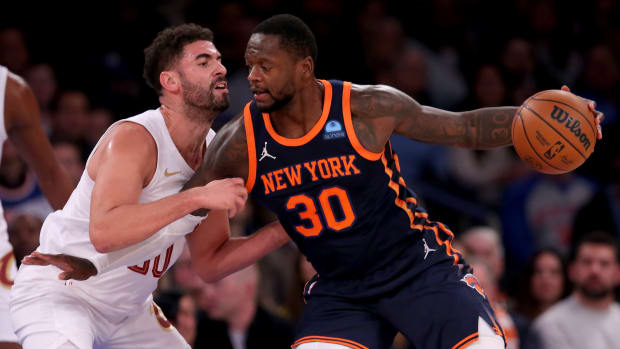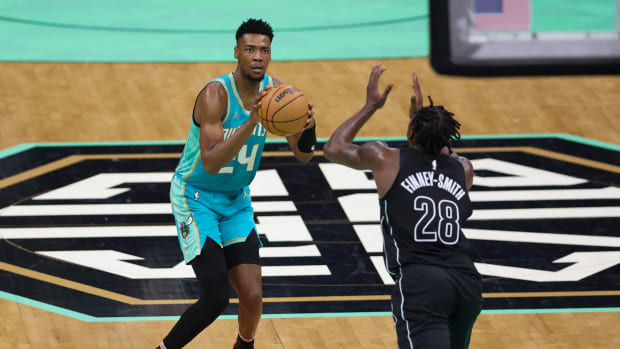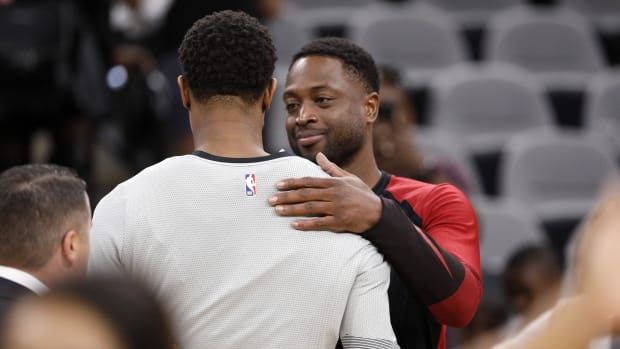When LeBron James needed advice in August about a protest action after the police shooting of Jacob Blake in Kenosha, Wis., he knew exactly who to call, even though the hour was late. Ol’ Number 44.
“When there’s things going on, when it’s chaos, when people don’t know which move to make or how to handle a situation,” James said then, “the best thing you can do is have someone that you can talk to and give you guidance and have that type of leadership. And I’m lucky enough to have a friend that gave us those words of leadership.”
A friend. That’s how LeBron described Barack Obama, who did indeed take the call and provide advice, albeit sleepily. “I told all these guys, ‘Y’all need to set up a more permanent structure so you don’t call me at midnight,’” Obama said later.
Almost a half-century earlier, on a September day in 1971, Oscar Robertson walked into a Senatehearing room with no friends in high places. He was 32, a few months removed from his 11th straight All-Star season and what would be the only NBA championship he would win, with the Bucks, in a sweep of the Baltimore Bullets. As the head of the players union, he was also 17 months removed from filing an antitrust lawsuit against the league. At Robertson’s side was union counsel Larry Fleisher, a brilliantly acerbic Harvard-educated lawyer with a unique talent for pissing off just about everybody. In front of Robertson, a reluctant speaker in any situation, was the mostly hostile nine-member Senate Subcommittee on Antitrust and Monopoly, which seemed likely to vote in favor of granting pro basketball owners an antitrust exemption that would allow for the merger of the NBA and the ABA, thus limiting player movement and reducing their earning power.
“Mr. Chairman, my name is Oscar Robertson,” he began. “This will be my 12th year in professional basketball, and I’ve seen some of the ills that were brought on the ballplayers when I first started playing basketball, and I think it’s terribly wrong for anyone to limit anyone’s ability to earn more money.”
Some of the senators, no doubt avowed capitalists, found this idea jaw-dropping.
“You seem to have done pretty well,” said Senator Roman Hruska, a conservative Republican from Nebraska who throughout the hearings seemed to be one step away from calling Robertson “uppity.” “Do you think you are worth more than the one hundred thousand dollars you are getting?”
In a whisper, Fleisher suggested that Robertson answer: “There may be those who wonder if you are worth the money you are getting from taxpayers.”
The Big O smiled but came up with his own response.
“To be honest and frank,” he said to Hruska, “I think so.”
The room broke out in laughter.
That was Robertson. He eschewed the punch line and eventually, with the help of North Carolina Senator Sam Ervin, wore down the committee. The 6' 5" guard did it that way on the court, too. Dribble, dribble, dribble, back defender down, always methodical, create space with not-so-subtle elbows and hips and go up for the fundamentally perfect jump shot or the pass that would lead to a basket. The proposed amendment never made it out of committee, and the legal battles fought by Robertson and others led to the dismantling of the odious reserve clause and the advent of free agency.
Yet the suit that got things started (Robertson v. the National Basketball Association) and the 1976 statute that ended the battle (the Oscar Robertson Rule, which eliminated compensation for teams that lost free agents) seem little remembered today. Robertson’s myriad battles—against racism; regressive institutions; rules that limited the freedoms, not to mention the finances, of players—took place in a far less accepting environment, without the benefit of 48 million Twitter followers (the LeBron number) to influence opinion, back when almost everyone wanted players to shut up and dribble. Robertson sure did dribble, but on important issues he never shut up, fighting with a stoic sullenness that sent this message: This is no fun. But I carry on.
“I always admired his game, of course, but what was most admirable about Oscar was his willingness to speak out,” says Jerry West, against whom Robertson will be perennially measured. “It was much harder to do that back in our day, and very few had the courage that Oscar did.”
“Oscar paved the way for free agency as we know it in the NBA,” commissioner Adam Silver says. “There is a long tradition in our league going back to Oscar and others, including Bill Russell, who spoke out about civil rights issues. It’s a culture that’s been passed down from generation to generation, and Oscar led the fight.”
Now, it would be a stretch to say that the 82-year-old Robertson is forgotten. There is the iconic Big Vowel for which he is known (one of the game’s first great nicknames, though West called him Donut), and the equally iconic photo of Robertson rebounding in his University of Cincinnati days, legs spread in a straight line like a gymnast doing an airborne split, everyone else floor-bound and in apparent awe. And of course Robertson’s name was endlessly recalled during Russell Westbrook’s 2016–17 triple-double season (he’s had two more since then) and will continue to be as long as versatile players chase the standard that Oscar set in 1961–62, his second year with the Cincinnati Royals: 30.8 points, 12.5 rebounds, 11.4 assists.
But that is exactly the point: We see numbers with Robertson but not a clear image of the man, unlike other NBA advocates of social justice, such as Russell and Kareem Abdul-Jabbar, whose courage in speaking out accompanies our memories of their greatness as players. Robertson should be with them. But in any metaphorical NBA photo the Big O stands outside the three-point line, even though he, along with other Black players such as Russell, Wilt Chamberlain and Elgin Baylor, revolutionized the league in the late 1950s and early ’60s.
Beyond that, Oscar’s Indiana background (he was born in Tennessee, but his family moved to Indianapolis when he was four) establishes him as a major part of a major chapter in basketball’s creation story in the Hoosier State. But Robertson represents the flip side. His is the anti-Hoosiers tale, the kid who was the wrong color and lived on the wrong side of town and had to claw and scratch his way to the pantheon in a state where white players with “fundamentally sound” games—Homer Stonebraker through Stretch Murphy through Bobby Plumb through Rick Mount through Larry Bird through Steve Alford through Damon Bailey—were held up as the standard. Robertson should be viewed through the lens of a man who grew up hard, scarred by racism and a thousand little cuts, who used them for fuel, refusing to yield, refusing to forget. And in terms of his legacy, he paid a price for that.
In March 1954, Robertson played in the Indiana state tournament against Milan High—the real-life rural school that was the basis for the Hoosiers version, Hickory High. He was a baby-faced sophomore guard at Crispus Attucks, the all-Black high school (named for a Black seaman who is believed to be the first person killed in the 1770 Boston Massacre) that had opened in 1927 as, according to the Indianapolis Star, “parades of masked Klansmen” demonstrated outside.
While Robertson’s team lost to Milan 65–52 in the semifinals, he has never said anything bad about the team or its star, Bobby Plump, represented by the square-jawed Jimmy Chitwood in Hoosiers. “Bobby Plump shot the hell out of the ball and ended up leading all scoring with twenty-eight,” Oscar wrote in his 2003 autobiography, The Big O: My Life, My Times, My Game. Milan went on to beat Muncie Central in the final on Plump’s last-second jumper, which fueled the climactic scene of Hoosiers, and this is where Oscar has problems.
In real life Milan defeated a team with two Black players; in the movie, all-white Hickory beats an all-Black team, entirely coached by Black men and whose rooting section consists of Black men, women, boys and girls. Until the early 1940s, a rule established by the Indiana High School Athletic Association, which was under the control of a tinhorn dictator named Arthur Trester—there are no dictators so tinhorn as those who rule over amateur sport—prohibited what King Arthur, as he was known, defined as “non-public” schools from participating in the state tournament. This was a catch-22 designed to keep Black students out, since an overwhelming majority of them were forced to attend segregated schools. Such schools, under Trester’s rule, didn’t qualify as public since they had a selective enrollment. Parochial schools were in the same boat, so they set up their own thriving tournament, but there weren’t nearly enough Black schools to do that. So until 1941, Black players were unable to participate in Indiana’s most hallowed sporting event, which began back in 1911.
Fortunately, the great Crispus Attucks teams came along post-Trester and, led by Robertson, won the next two state titles. Incredibly, they were the first big-city school to win it all, further proof that Indiana basketball meant rural basketball, the game having spread like a virus (unsavory reference acknowledged) from small town to small town, linked by thousands of backboard-less rims hung on barns.
But something happened after that first title, in 1955, that Robertson never forgot: Instead of taking the traditional parade route through downtown Indianapolis, the all-Black team’s motorcade went through the poor section known as Naptown, a change made during an earlier closed-door meeting between city fathers and the mayor. Writes Robertson in his autobiography: “Even now I wonder: Did they think we’d riot because we were primitive animals, beasts who could do nothing but destroy, or maybe, just maybe, did they worry because they knew we had good cause and were entitled to our rage?”
One can feel that rage from Robertson, who, as his team celebrated with a bonfire at Northwestern Park, seethed when he thought about the center-city celebration afforded Milan the year before: “I knew all those stories about their long ride back to Milan, women coming out of houses with fresh pies for them, men standing on the lawn with flags,” he wrote. “Why was that honor denied us?”
If the detour around Monument Circle lit Robertson’s awareness, a few incidents at Cincinnati, where he enrolled in 1956 as the school’s second Black athlete, kept it burning. On a road trip to Houston as a sophomore, he was asked to check out of a hotel by the manager and had to stay in a dormitory at all-Black Texas Southern. He contemplated boycotting the next night’s game at North Texas State, standing at midcourt before tip-off with arms folded while fans threw programs at him. But he decided to play and did all right—37 points and 18 rebounds in a 94–53 Bearcats victory.
As a junior playing in the Dixie Classic on the campus of North Carolina State, he heard the n-word repeatedly along with shouts of “porter” and “redcap.” Robertson (who declined to be interviewed for this story) later said he contemplated quitting basketball, not just because of the insults but also because he felt he didn’t get adequate support from his Cincinnati teammates and coach George Smith.
Drafted as a territorial pick by the Royals in 1960—he went No. 1, one spot ahead of West, with whom he had co-captained the gold-medal-winning Olympic team in Rome—Robertson was rarely happy in Cincinnati, even as he began to put up unprecedented numbers. He never felt loved, refused to pretend otherwise and was consequently targeted by the local press.
Now, there is hardly a Black player from the Robertson era who cannot tick off a menu of indignities. Russell endured endless racism in Boston. Chamberlain, beyond the color of his skin, spent his entire life being pointed to as a freak. As a rookie in 1959, Baylor sat out an exhibition game in Charleston, W.Va., when the Minneapolis Lakers were thrown out of a downtown hotel because their roster included Baylor and two other Black players.
But while it is perilous to play the who-had-it-worse? game, particularly a half-century later by a white writer, the others each had a balm. Russell’s was 11 championships. Baylor moved to wide-open Los Angeles after his rookie year and teamed up with West to create a consistent winner, albeit one that couldn’t get by Russell’s Celtics in the Finals. And Wilt was a personality of an entirely different sort, comfortable in whatever situation, a man of the world who enjoyed his time in the big cities of Philadelphia, San Francisco and finally L.A.
Robertson, by contrast, dealt with inept ownership in conservative Cincinnati, where the franchise consistently struggled at the gate and on the court. He fought contract battles and held out a few times, his only weapon before free agency, and in the process alienated fans. General manager Pepper Wilson once called him greedy, and Robertson answered: “If I’m greedy, I learned it from you.” Worst of all, his undermanned Royals never made it to the Finals, mostly because they, too, couldn’t get by Russell’s Celtics. And when Boston immortal Bob Cousy was hired in 1969 as player-coach and presumed franchise savior, the pairing with Robertson was toxic. Public opinion went heavily in favor of Cousy, the (white) standard for point guard play in the 1950s, instead of Robertson, the (Black) standard for the next two decades, until Magic Johnson came along. Oscar’s rancorous time in Cincinnati—how much he wanted to leave the Royals and, by the end, how much management wanted him out, All-Star appearances be damned—can be capsulated by this fact: After 10 years with the Royals he was traded to Milwaukee for Charlie Paulk and Flynn Robinson, each of whom played just one season in Cincinnati. Robertson went on to team with Abdul-Jabbar and win the championship in 1971; the Royals left town the next year.
In the midst of his gloomy time in the Queen City, Robertson in 1965 took on the thankless job of president of the players union, the first Black head of any national sports or entertainment labor union. He affixed his name as the lead plaintiff in the case against the NBA and came to Washington to testify, and later, after he retired and no team attempted to hire him as a coach or consultant, he became the first president of the Retired Players Association. His closest connection to the league after his playing days was as a broadcaster for CBS in 1974–75, the season after he retired, and that lasted only one year.
“Anyone who’s a fan of the game knows that Oscar is one of the greatest players in history,” says Silver. “I’m very close with Oscar and I respect that he chooses to live a private life.” But though Robertson has had a successful career as a businessman in Cincinnati, one wonders why he isn’t closer to the game. David Stern brought several NBA legends back into the fold, particularly Russell, but Stern and Robertson were not simpatico, and it’s impossible not to take note that the late commissioner was the NBA’s attorney in Robertson’s suit against the league back in the 1970s.
Then, too, Robertson has been a man without a franchise. He was with Milwaukee for only four seasons and seems no more a Buck than Abdul-Jabbar does. After the Royals traded Oscar they relocated to Kansas City–Omaha, became the Kings and then moved on to Sacramento. But who remembers that? Russell and Cousy are eternal Celtics. Baylor, West and Kareem are eternal Lakers. But what is the Big O?

Despite occasional appearances, like this one at a Bucks game in May 2019, Robertson has largely been on the outside looking in since he retired.
Greg Nelson/Sports Illustrated
There is little doubt that Oscar’s prickly personality and his inability to forget past indignities had much to do with his alienation. In past interviews, including one with this reporter, Robertson has been loath to declare that he has been excluded from the league, while also making clear that it has never put out the welcome mat for him. In a 2002 interview with Sports Illustrated, his wife, Yvonne, to whom he has been married since 1960, said, “He would appreciate getting the respect not only for what he did on the court, but also for what he did in the courts. So few of today’s players have any idea of what he fought for, what he stood for.”
Today, 46 years after Robertson’s retirement, his versatility nonpareil with the exception of LeBron—can we agree on that, people?—he should be front of mind when we consider how far we’ve come. We live in an era when James, from the bully pulpit of a locker room, can call for the arrest of Louisville police officers in the Breonna Taylor killing or help organize a campaign against voter suppression that led to 19 NBA arenas opening up as voting sites. And while today’s outspoken superstars no doubt pay a price for their opinions—social media threats and insults that the public will never know—they also live at a time when outspokenness is accepted, even recommended. The battles in the 1960s and ’70s were mostly lonely ones that came at a great cost.
So in the final analysis of Oscar Robertson, yes, we must look at the numbers, for they define his greatness. But let’s not make him more stat than symbol, more math than man. His inner strength, too, was pure triple double.






































